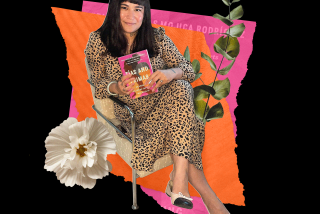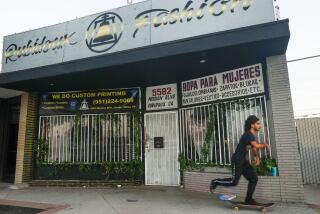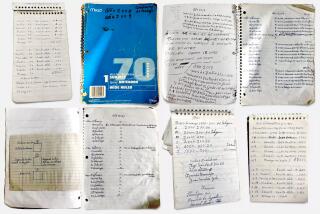Imelda Marcos Uses Past Poverty as Asset in Court
NEW YORK — The Imelda Marcos who campaigned beside her ambitious husband when he won the Philippine presidency 25 years ago was an aristocrat--a Manila beauty queen from the wealthy and prominent Romualdez family. At least, that was the official story.
Anyone who later suggested that she was once so poor she lived in a garage was attacked as a liar or a communist, an enemy of President Ferdinand E. Marcos and of the Philippines.
After Marcos seized dictatorial control of the country in 1972, his wife sent bulldozers to destroy the garage where, as one of the Romualdez family’s poor relations, the little girl they called “Meldy” had slept on milk crates.
But today the Imelda Marcos accused of looting her country--and who faces federal charges of fraud and racketeering here--is openly claiming to be that former peasant girl who overcame barefoot poverty. The history she tried to rewrite with a bulldozer is now an important theme of her defense, a story to win sympathy from a New York jury.
That irony has not been missed by one woman seated each day behind Mrs. Marcos in the courtroom crowd--Carmen (Chit) Pedrosa, the author whose 1970 book, “The Untold Story of Imelda Marcos,” revealed the first lady’s lowly roots.
Pedrosa was offered bribes, threatened with libel suits and finally ordered arrested, forcing the author and her family into exile in Europe.
“And to think that I went on a 20-year exile because I wrote that book,” she said. “Telling the truth cost me my home; now Imelda wraps herself in the same truth.”
But this is a trial filled with ironies and conflicting views of history. It has turned a Manhattan courtroom into an odd battleground over the image of a woman once regarded among the world’s richest and most powerful.
A month ago, attorneys opened their defense of Mrs. Marcos referring to her as “this poor girl who drank out of foxholes during the war,” who couldn’t afford to buy books in school and who moved from rural Leyte to the big city of Manila with only five pesos in her pocket.
Even before the trial opened Mrs. Marcos sat for a lengthy interview with the Asian Television Corp. in which she said: “I feel for the poor--I’ve been there.”
During the four-hour documentary that was televised in the Philippines, Mrs. Marcos also said she knew what it was like to be hungry. “I have been deprived,” she said.
The contrasting images of poverty and status have long been part of Mrs. Marcos’ life. Once she became first lady, her own family kept separate photo albums, according to Pedrosa. A blue book contained pictures consistent with her claim to aristocratic roots. A red book was described as “the real one.”
But the former first lady has come a long way from those days of deprivation. Prosecutors have only begun to reveal details of her sometimes breathtaking spending sprees, but already the jury has heard about:
--How she persuaded her husband to let her buy a $51-million Manhattan skyscraper in 1981 by crying and pleading with him to give it to her as pamana , a Tagalog term for gift or inheritance.
--The 24 “bricks of gold” she gave him on the couple’s 24th wedding anniversary in 1978.
--A sort of cash takeout service provided to her by the Philippine National Bank branch in New York. Regular $100,000 cash deliveries were allegedly made to her Waldorf Towers hotel suite that amounted to several million dollars.
--How she dispensed thousands of dollars in bundles of cash to the wives of Philippine generals during a trip to South Korea.
--Her “voracious appetite” for jewelry, art and other luxury items. Not to mention the shoes.
Defense attorneys are trying to counter those images with images of their own.
To help understand Mrs. Marcos’ passion for jewelry, for example, attorney Gerry Spence told jurors to consider the story of “a little child” whose family had one asset of value to get them through World War II: “one necklace.”
“It was all they had to live on during the war,” he told the jurors.
“The evidence will show you a woman who as a little girl carried that necklace, the family entrusted it to her . . . and every once in a while they would take a bead off of the necklace and trade it for something to eat. The necklace got smaller and smaller and one day when the war was over, almost all of the beads were gone--but the family was alive.”
It is an account disputed by Pedrosa, the author who interviewed members of the Romualdez family--including some of Mrs. Marcos’ sisters--more than 20 years ago. Pedrosa called the necklace story “a fantasy.”
However, she has no dispute with general accounts of Mrs. Marcos’ youthful poverty, some of which are almost certain to be heard by jurors once the defense gets its turn to present evidence.
Ironically, Pedrosa’s account of the life of Imelda Marcos provides defense attorneys with some of the most extensive details, outside of family sources, of the poverty and sadness that marked her difficult early years.
“She tried to hide her past at first because Ferdinand Marcos needed a political asset. She was beautiful, and she was a Romualdez, but she was from the wrong side of the family,” Pedrosa said.
A bit like Cinderella, Imelda was estranged from her father’s first set of children. The first family lived in “the big house” and Imelda, the eldest of the second set of children after her father remarried, lived in the garage with her younger siblings. According to Pedrosa’s account, Imelda’s father was a dreamer, a romantic and a business failure.
Imelda later lived with a rich Romualdez uncle and his family while she attended school, but she had to share a room with the housekeeper and was excluded from the family’s inner circle. It was as if she was still “one of the garage people,” Pedrosa wrote.
In an interview at the Philippine Center on Manhattan’s 5th Avenue, where she is acting as chief spokesperson for the Philippine government during the trial, Pedrosa called it “a sad story, really--but now she can use it.”
Pedrosa, who did not return to the Philippines until President Marcos was deposed in 1986, said she fears jurors will not be told that Mrs. Marcos “was someone who caused so much suffering” in the Philippines.
The author blames poverty for creating in Mrs. Marcos “an obsession with wealth.”
Because of her past and her fear of being poor “Imelda was willing to impoverish her nation,” Pedrosa said. “She had a Scarlett O’Hara thing--she couldn’t stand ever to be poor again.”
More to Read
Sign up for Essential California
The most important California stories and recommendations in your inbox every morning.
You may occasionally receive promotional content from the Los Angeles Times.










